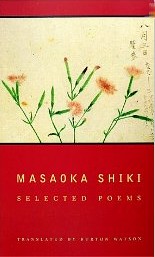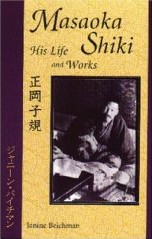Haiku of Masaoka Shiki
Masaoka Shiki
 Books of Poetry.
Books of Poetry.
 Voice.
Voice.
 Haiku Reform.
Haiku Reform.
 Tanka Reform.
Tanka Reform.
 Time Line.
Time Line.
Books of Poetry (alphabetical)
Masaoka Shiki: His Life and Works
by Masaoka Shiki, translated by Janine Beichman
Masaoka Shiki: Selected Poems
translated and introduced by Burton Watson
- 1-page Chronology.
- 13-page Introduction.
- 144 haiku.
Several examples are below in
Voice.
- 34 tanka.
- 4 kanshi (poems in classical Chinese).
- 8 pages of references and bibliography.
Voice: aspects of the haiku of Masaoka Shiki
Watson
says that Shiki wrote more than 25,000 haiku.
Different translators
(Beichman,
Blyth,
Watson)
mostly choose to translate different haiku, on the order of 100 each.
Some features of his haiku:
- Openness and naturalness in writing.
- Advocated for and used the technique of shasei or "sketch from life",
with open and natural writing that made minute observations of his surroundings, and created emotion in his work by
manipulating the images he found.
- Flexibility in allowing him to draw upon scenes in his memory.
- A significant portion are tied to various particular occasions (occasional poems)
that their meaning eludes today's reader.
- Often used alliteration.
- Often used assonance.
- Evoked emotion by apt juxtaposition of images, as in:
I eat a persimmon
and a bell starts booming --
Hôryû-ji
[Translator Watson.]
[Hôryû-ji is an ancient and venerated
Buddhist temple in Nara.]
|
- Other samples:
A carp leaps up
crinkling
the autumn moonlight
[1893. Translator Watson.]
|
Always someone resting there --
a lone rock
in the summer field
[1894. Translator Watson.]
|
Swatting mosquitoes --
blood stains
on the war tale I'm reading
[1896. Translator Watson.]
|
After I'm dead
Tell them
I was a persimmon eater
who liked haiku
[1897. Translator Watson.]
|
I think I'll die
eating apples,
in the presence of peonies
[1899. Translator Watson.]
|
Haiku reform
These features of the short poem were not challenged by Shiki (though some
later poets have abandoned them):
When Shiki began writing haiku, most haiku being written were satire, wordplay, or vulgarity.
Shiki:
- Rejected being bound by conventions to the past.
- Rejected the older terms of hokku
and haikai
used for the 5-7-5 stand-alone poem,
as those terms had been used for centuries in the context of linked verse,
renku.
- Established the term
haiku
for the 5-7-5 stand-alone poem.
- Criticized the low level of literary worth and inspiration in
haiku being created,
and their misuse for:
- satire
- vulgarity
- wordplay
- Rejected the use in haiku of:
- puns
- allusions to earlier literature
- miniature stories
- Preferred factual types of haiku; highlighted those of
Yosa Buson
over those of
Bashō.
Tanka samples
some persimmons
were sweet,
some bitter —
those with a trace of bitterness
were better, yes better, in taste!
[1897. Translated by Shinoda and Goldstein.]
|
Tanka reform
Brilliant book with a 126-page introduction.
Shiki's tanka arranged by year stating with some of his earlier tanka like this written in 1897:
.
Based predominantly on data in
Burton Watson's translation of Masaoka Shiki's
Collected Poems.
- 1600
- Start of Edo period.
- 1644
- Birth of
Matsuo Bashō.
He would become the first poet to compose independent hokku
(or in Shiki's term, haiku).
Shiki would become critical of
Bashō's
haiku.
- 1694
- Death of
Matsuo Bashō.
- 1714
- Birth of Yosa Buson.
- 1763
- Birth of Kobayashi Issa.
- 1783
- Death of Yosa Buson.
- 1827
- Death of Kobayashi Issa.
- 1867
- Birth of Masaoka Shiki.
End of Edo period.
- 1868
- Meiji Restoration.
The abolition of feudalism in the next years impoverished many samurai,
including his father.
- 1870
- Birth of his sister, Ritsu.
- 1872
- Death of his father.
- 1883
- Goes to Tokyo, aided by an uncle
- 1884
- Approximate start of his writing poems
in haiku
form.
- 1889
- Coughs up blood, showing first sign of infection by tuberculosis.
Although this would kill him in
1902, he resists it strongly.
- 1890
- Enters Tokyo University literature department.
- 1891
- Begins self-education in the history of the form of
haiku
and starts developing his Haiku bunrui
(Classified Collection of Haiku).
- 1892
- Withdraws from Tokyo University literature department,
to devote full time to creative work.
Becomes haiku editor of Nippon, where he will publish his own
haiku
and those of others.
Begins
haiku reform.
- 1893
- haiku:
A carp leaps up.
- 1894
- Outbreak of Sino-Japanese War.
haiku:
Always someone resting there.
- 1895
- Arrives in China as a War correspondent, but reaches after the outbreak of Sino-Japanese War.
Hospitalized on his return.
The tuberculosis has settled into his spine, causing pain and making it very difficult to walk.
- 1896
- haiku:
Swatting mosquitoes.
- 1897
- haiku:
After I'm dead.
- tanka:
some persimmons
- 1898
- Began an project to reform
tanka
similar to the way that he had reformed
haiku.
- 1899
- Publishes
Haijin Buson, influential study of haiku poet Yosa Buson.
- haiku:
I think I'll die.
- 1900
- Begins study of Manyô'shû.
- 1902
- Death of Masaoka Shiki.
Masaoka Shiki: His Life and Works (new version 2002; first published ).
- 1982
- First publication of Janine Beichman's translation of Masaoka Shiki's work:
Masaoka Shiki: His Life and Works.
- 1997
- Publication of Burton Watson's translation of Masaoka Shiki's
Collected Poems.
- 2002
- Revised publication of Janine Beichman's translation of Masaoka Shiki's work:
Masaoka Shiki: His Life and Works;
first published
.
-
Links and Books.
-
[Thanks for visiting.]
 Modern Haiku.
Modern Haiku.
 The Heron's Nest.
The Heron's Nest.
 Roadrunner e-magazine.
Roadrunner e-magazine.
 Highlights of Poetry.
Highlights of Poetry.
 Index of poetry.
Index of poetry.
 How to Write Poetry.
How to Write Poetry.
 Books read.
Books read.
 Yuki Teikei Haiku Society:
Yuki Teikei Haiku Society:
 Join.
Join.
 GEPPO magazine.
GEPPO magazine.
 Annual anthologies.
Annual anthologies.
 2007.
2007.
 2008
(a haibun).
2008
(a haibun).
 2010.
2010.
 Toward an Aesthetic for English-Language Haiku by Lee Gurga.
Toward an Aesthetic for English-Language Haiku by Lee Gurga.
 2004 Pescadero Haiku Weekend Workshop (including exercises) with Christopher Herold.
2004 Pescadero Haiku Weekend Workshop (including exercises) with Christopher Herold.
 Haibun.
Haibun.
 Haiku.
Haiku.
 Hay(na)ku.
Hay(na)ku.
 Rengay.
Rengay.
 Renku.
Renku.
 Tanka.
Tanka.
 Ballade.
Ballade.
 Concrete.
Concrete.
 Ghazal.
Ghazal.
 Lai.
Lai.
 Pantoum.
Pantoum.
 Prose poem.
Prose poem.
 Rondeau.
Rondeau.
 Rubáiyát.
Rubáiyát.
 Sestina.
Sestina.
 Skaldic verse.
Skaldic verse.
 Sonnet.
Sonnet.
 Terza rima.
Terza rima.
 Triolet.
Triolet.
 Tritina.
Tritina.
 Villanelle.
Villanelle.
 Bashō.
Bashō.
 Chiyo.
Chiyo.
 Jane Hirshfield.
Jane Hirshfield.
 J. Zimmerman.
J. Zimmerman.
 J. Zimmerman (haiku).
J. Zimmerman (haiku).
 J. Zimmerman (tanka).
J. Zimmerman (tanka).
 Marianna Monaco.
Marianna Monaco.
 Hosai Ozaki.
Hosai Ozaki.
 Patricia Donegan.
Patricia Donegan.
 Patricia J. Machmiller.
Patricia J. Machmiller.
 Shiki (haiku).
Shiki (haiku).



